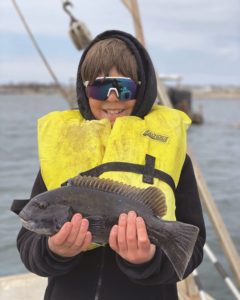The unrelenting winds from the northeast continue to pummel the Outer Cape, and the prediction is for them to continue throughout this week. With these northeast winds come cooler than normal temperatures and a dampness that goes right to your bones. This is making it difficult for spring fishing to gain any traction.
There are encouraging signs in spite of this inhospitable spring weather pattern. Reports from the canal are that some decent-size striped bass have shown up and are being caught along the west end. There are also bass showing up on the back side of the Cape, though up past Chatham.

Fishermen from that way say they are also seeing more schools of pogies (menhaden) than they have ever seen before. On one hand, it’s nice to see pogies, a staple food source for striped bass, bluefish, and tuna, in huge numbers. On the other hand, if these schools stay where they are, the bass could theoretically also stay put to be near their food, with no motivation to look our way.
This is exactly what happened last year, only they were feeding along the South Shore and on up to the Boston Harbor area instead of on the Cape. We never saw the tremendous numbers of pogies here; consequently, we never really got a shot at the main body of striped bass — and we saw very few really large ones.
But the good news is mackerel have come into our harbor and are pretty thick in the horseshoe cove at this writing. Flounder continue to bite in deeper waters off the Pamet on down to the Wellfleet Harbor entrance.
Tautog are beginning to bite in our inner harbor. These are not migratory fish. They just move off into deeper water when it gets cold and come back to shallower water to feed and spawn as the water warms up past 50 degrees. These fish are very selective in where they choose to reside and what they eat. Their diet consists mostly of crabs, mussels, and clams, and they have a good set of teeth and powerful jaws to crush those foods.
Because what they eat lives around underwater structures, that is where you must fish if you’re after tautog. So, for the inner harbor, the breakwater is a perfect place to toss a green crab or a piece of clam in hopes of catching one. Tautog are strong fighters and you will know when you have one hooked, as they hit the bait hard and will run your rig into the rocks if given the opportunity. Because of that, losing a fish and your rig is a common occurrence and part of the challenge of tautog fishing.
These fish have white, flaky meat and a mild flavor, although their thick skin and bone structure make them a little challenging to clean. A long flexible filet knife makes the job easier.
The right whales seem to be leaving our area and continuing north towards the Bay of Fundy. This coming week, the government-imposed ban on trap gear will expire and commercial lobster fishermen will finally get to put their traps out, though they will now be handicapped by diesel fuel prices north of five dollars a gallon. I wonder how the high cost of fuel is going to affect the price of lobsters this year.
If it’s not one thing it’s another for these men and women who lobster for a living.



